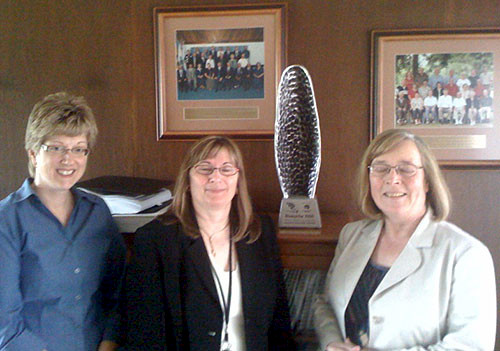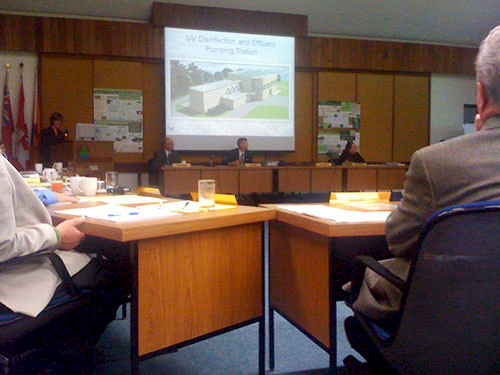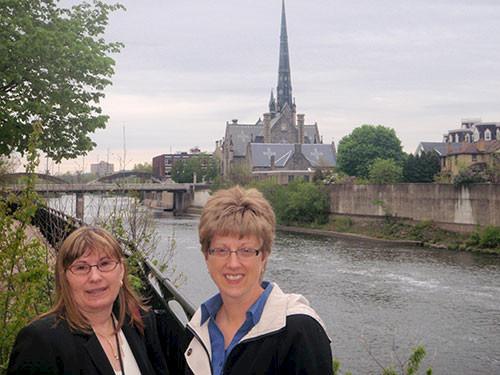Visit with Grand River Conservation Authority
Bill Dennison ·Ten years ago, the Grand River Conservation Authority was the recipient of the 2nd annual Theiss International Riverprize in Brisbane, Australia. Peter Krause was the chair of the authority board at the time and he traveled to Brisbane to receive the award. I was on the Riversymposium planning committee while teaching at the University of Queensland and met Peter at this time. Ten years later, as part of a visit to Southern Ontario to teach a science communication course, I made a visit to 'The Grand' to talk with their staff about their efforts. In a fitting turnaround, Peter Krause is living in Brisbane and working as the Chief Executive Officer of the International Riverfoundation, the organization formed by Martin Albrecht to foster the International Riverprize (several hundred thousand dollars awarded annually), sponsor delegates to the annual Riversymposium, and stimulate twinning projects where Riverprize recipients partner with conservation groups in less developed parts of the world.

The Grand River Conservation Authority (GRCA) is just beyond the green belt that surrounds the city of Toronto. The Grand River flows to the southwest into Lake Erie and is ~300 km (~185 mi) long. There are about 1 million inhabitants living in 38 municipalities and 2 First Nations. There are 7 large dams forming water reservoirs for drinking water that the GRCA operate. The largest municipalities in the watershed are Cambridge (where GRCA headquarters are located), Guelph, Branford and Waterloo. Every two weeks, the board of the GRCA meets in the morning and I attended the final session of one of these board meetings. As a visitor I was introduced and I congratulated them on their Riverprize ten years hence, on their ongoing twinning project with a watershed in Argentina, and thanked them for what they were doing on behalf of Lake Erie, which is shared with the U.S. Following the board meeting, we had lunch and I met the Chair, Alan Dale and the GRCA Chief Administrative Officer Paul Emerson.

After lunch, I met with 15 senior staff of the GRCA, organized by Sandra Cooke, a water quality analyst who took our Science Communication course in 2009 in Cambridge, Maryland. Joe Farwell, the Assistant Chief Administrative Officer, gave an overview of the GRCA and then we had a discussion about the challenges and lessons learned in the ten years following the Riverprize.

From talking with the GRCA staff, it was clear that they were doing many things right including the following: 1) They were reinventing themselves periodically to stay fresh and dynamic, 2) They were engaging the community, 3) The scale that they were operating at was the landscape scale, which was the appropriate operational scale, 4) They were attempting to link the health of the Grand River to the health of the communities in the watershed, and 5) They continued to foster a twinning program with Argentina.
Their future challenges were similar to those we are facing in the Chesapeake Bay, climate change and population growth. Southern Ontario is not unlike the Mid-Atlantic region in that the climate projections indicate warmer, wetter winters with summer conditions in which droughts are punctuated with intense rain events. Population growth from the expansion of the Toronto (with over 4.5 million inhabitants, the largest Canadian city) is predicted to expand the population within the Grand River watershed dramatically, as the Grand is just beyond the Toronto green belt, thus is slated for population growth.
After learning about their various programs, I suggested two topics that they could improve upon; scientific research and environmental reporting. There are some excellent universities within the Grand watershed, including the University of Guelph, but little engagement of the scientists at these universities to support the conservation efforts by the GRCA. Of the 38 conservation authorities of Southern Ontario, only 9 are not currently producing report cards, including the Grand. We discussed the development of environmental report cards in both Australia and Chesapeake Bay to catalyze better environmental stewardship.
Following our discussion, Sandra Cooke and Barb Veale took me to see the Grand River as it flows through Cambridge, Ontario. An old mill site and historic churches provided a nice backdrop to the river. Interestingly, this is the third river in Cambridge I have seen this year; 1) my office at Horn Point Laboratory in Cambridge, Maryland looking over the Choptank River, 2) the Pardee Center of Boston University next to the Charles River where we had Conservation International workshops, and 3) the Grand River in Cambridge, Ontario.

The hope is that the Grand River and other successful examples of good environmental stewardship, like the most recent Riverprize recipient, Lake Simcoe Conservation Authority just north of Toronto, can be emulated in the myriad of other watersheds globally so that instead of being the exceptions, they become the rule.
About the author
Bill Dennison

Dr. Bill Dennison is a Professor of Marine Science and Vice President for Science Application at the University of Maryland Center for Environmental Science.
Next Post > The Next Frontier: Ecological Forecasting
Comments
-
Peter Krause 15 years ago
Hello Bill,
I just received the article on your visit to the Grand River Conservation Authority (GRCA). Thank you for profiling, what I believe is, a leading watershed management agency. Of course, it is the people and their passion for the environment that makes the GRCA a leader.
Also, thank for profiling the International Riverfoundation (IRF). Its' mission to revive and protect the world's rivers is critical to a healthy planet.
Cheers,
Peter

